Supply Chain Management Case Study Analysis
VerifiedAdded on 2020/05/04
|13
|3015
|157
AI Summary
This assignment requires students to critically analyze a provided supply chain management case study. The analysis should delve into the specific challenges faced by the company or organization in the case, identify potential areas for improvement within their supply chain operations, and propose practical solutions to mitigate identified issues. The focus is on applying theoretical concepts of supply chain management to a real-world scenario.
Contribute Materials
Your contribution can guide someone’s learning journey. Share your
documents today.
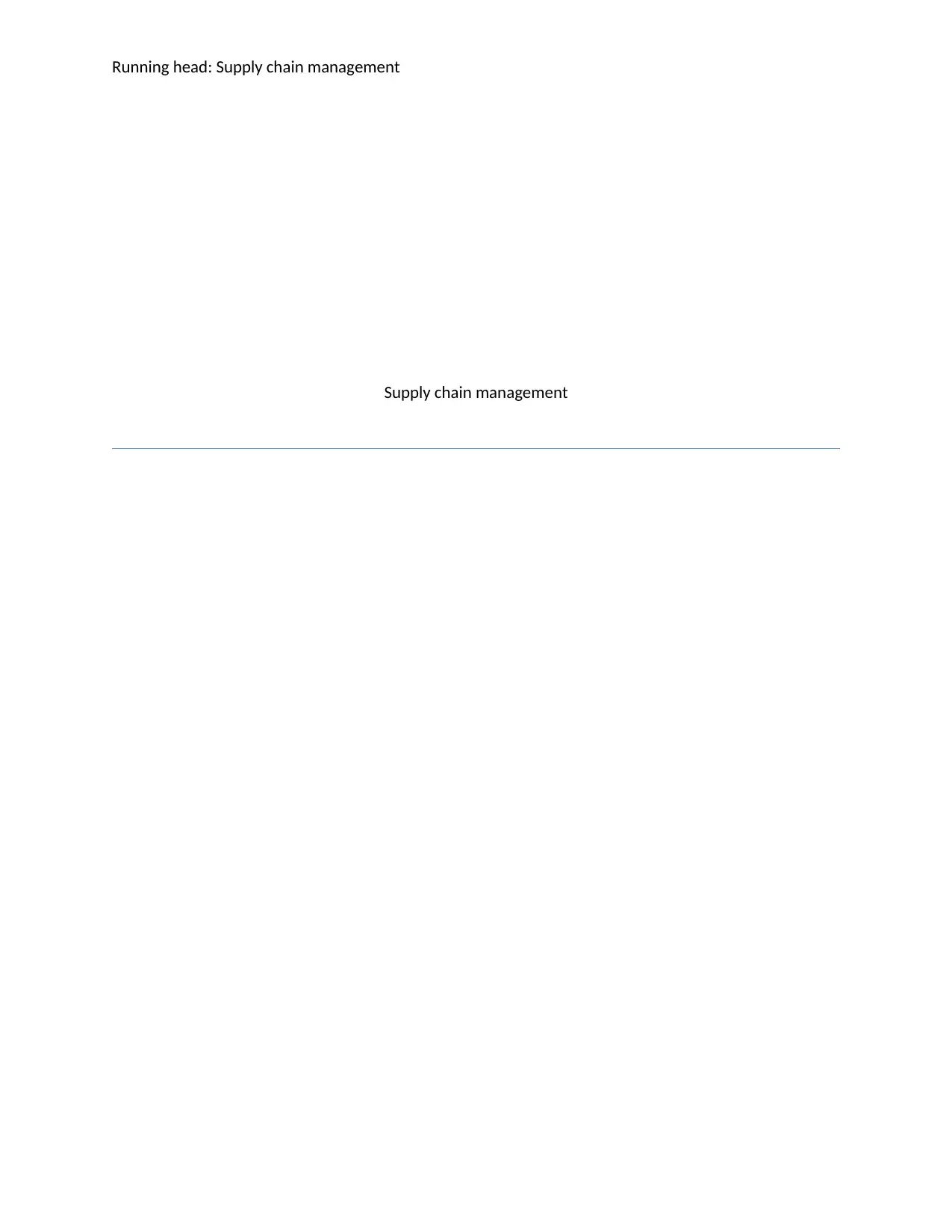
Running head: Supply chain management
Supply chain management
Supply chain management
Secure Best Marks with AI Grader
Need help grading? Try our AI Grader for instant feedback on your assignments.
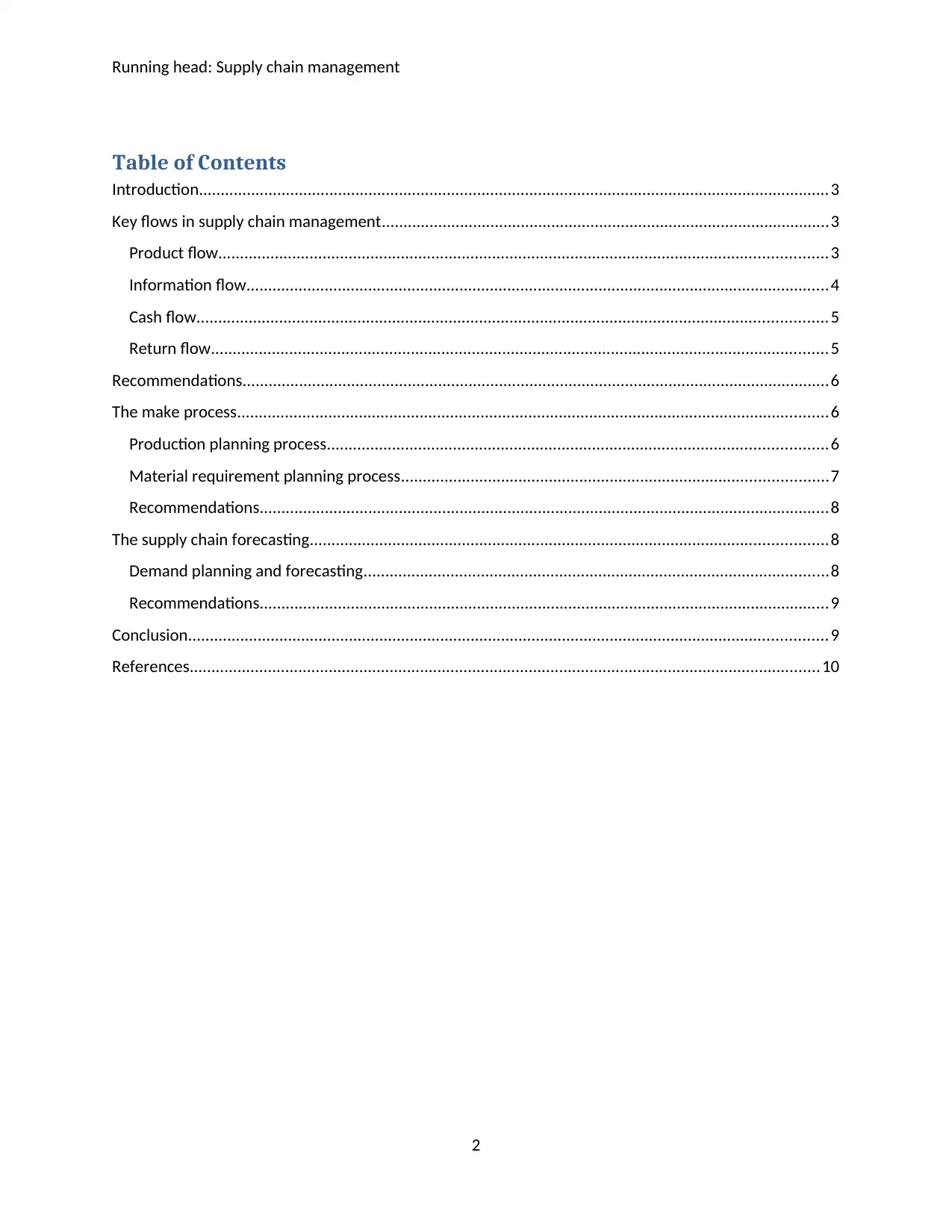
Running head: Supply chain management
Table of Contents
Introduction.................................................................................................................................................3
Key flows in supply chain management.......................................................................................................3
Product flow............................................................................................................................................3
Information flow......................................................................................................................................4
Cash flow.................................................................................................................................................5
Return flow..............................................................................................................................................5
Recommendations.......................................................................................................................................6
The make process........................................................................................................................................6
Production planning process...................................................................................................................6
Material requirement planning process..................................................................................................7
Recommendations...................................................................................................................................8
The supply chain forecasting.......................................................................................................................8
Demand planning and forecasting...........................................................................................................8
Recommendations...................................................................................................................................9
Conclusion...................................................................................................................................................9
References.................................................................................................................................................10
2
Table of Contents
Introduction.................................................................................................................................................3
Key flows in supply chain management.......................................................................................................3
Product flow............................................................................................................................................3
Information flow......................................................................................................................................4
Cash flow.................................................................................................................................................5
Return flow..............................................................................................................................................5
Recommendations.......................................................................................................................................6
The make process........................................................................................................................................6
Production planning process...................................................................................................................6
Material requirement planning process..................................................................................................7
Recommendations...................................................................................................................................8
The supply chain forecasting.......................................................................................................................8
Demand planning and forecasting...........................................................................................................8
Recommendations...................................................................................................................................9
Conclusion...................................................................................................................................................9
References.................................................................................................................................................10
2
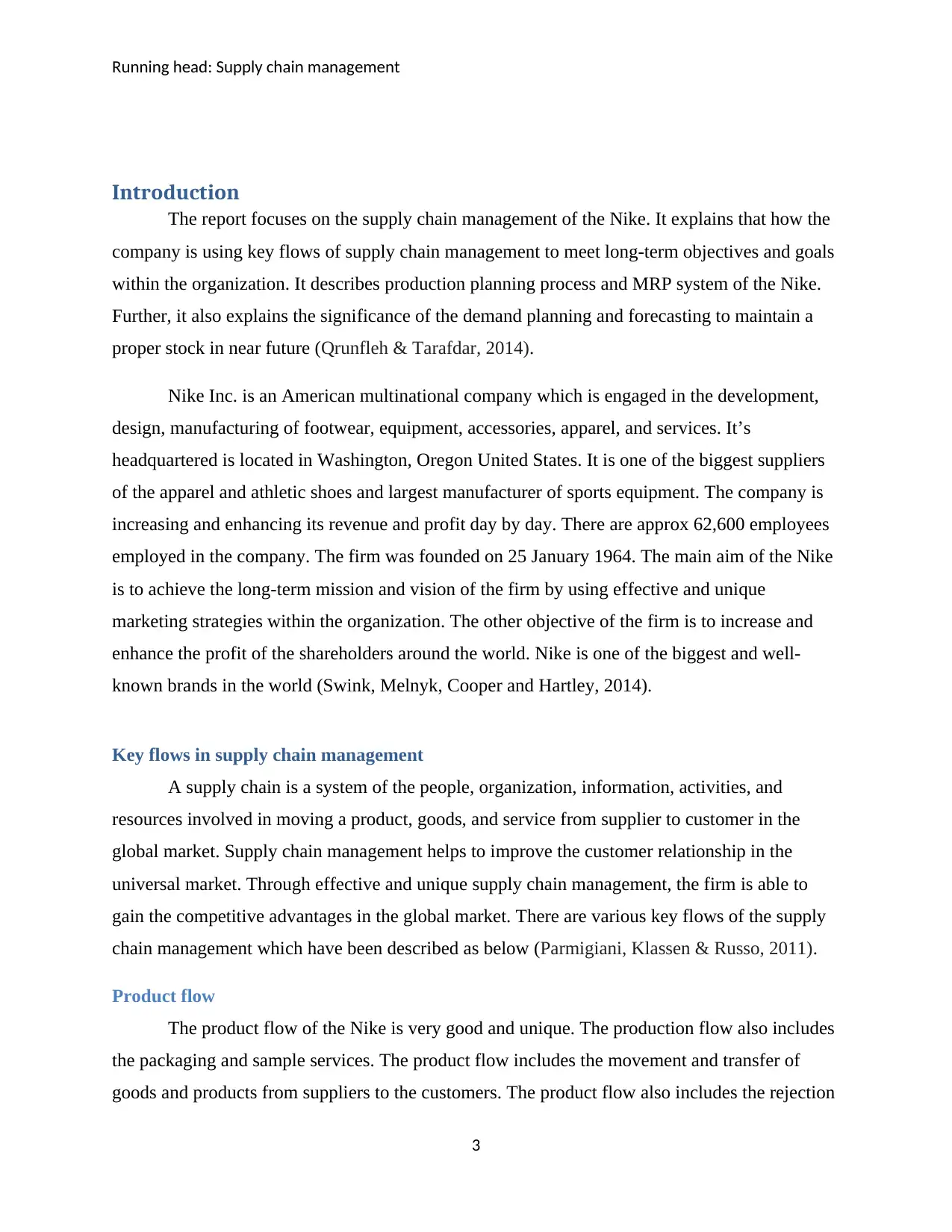
Running head: Supply chain management
Introduction
The report focuses on the supply chain management of the Nike. It explains that how the
company is using key flows of supply chain management to meet long-term objectives and goals
within the organization. It describes production planning process and MRP system of the Nike.
Further, it also explains the significance of the demand planning and forecasting to maintain a
proper stock in near future (Qrunfleh & Tarafdar, 2014).
Nike Inc. is an American multinational company which is engaged in the development,
design, manufacturing of footwear, equipment, accessories, apparel, and services. It’s
headquartered is located in Washington, Oregon United States. It is one of the biggest suppliers
of the apparel and athletic shoes and largest manufacturer of sports equipment. The company is
increasing and enhancing its revenue and profit day by day. There are approx 62,600 employees
employed in the company. The firm was founded on 25 January 1964. The main aim of the Nike
is to achieve the long-term mission and vision of the firm by using effective and unique
marketing strategies within the organization. The other objective of the firm is to increase and
enhance the profit of the shareholders around the world. Nike is one of the biggest and well-
known brands in the world (Swink, Melnyk, Cooper and Hartley, 2014).
Key flows in supply chain management
A supply chain is a system of the people, organization, information, activities, and
resources involved in moving a product, goods, and service from supplier to customer in the
global market. Supply chain management helps to improve the customer relationship in the
universal market. Through effective and unique supply chain management, the firm is able to
gain the competitive advantages in the global market. There are various key flows of the supply
chain management which have been described as below (Parmigiani, Klassen & Russo, 2011).
Product flow
The product flow of the Nike is very good and unique. The production flow also includes
the packaging and sample services. The product flow includes the movement and transfer of
goods and products from suppliers to the customers. The product flow also includes the rejection
3
Introduction
The report focuses on the supply chain management of the Nike. It explains that how the
company is using key flows of supply chain management to meet long-term objectives and goals
within the organization. It describes production planning process and MRP system of the Nike.
Further, it also explains the significance of the demand planning and forecasting to maintain a
proper stock in near future (Qrunfleh & Tarafdar, 2014).
Nike Inc. is an American multinational company which is engaged in the development,
design, manufacturing of footwear, equipment, accessories, apparel, and services. It’s
headquartered is located in Washington, Oregon United States. It is one of the biggest suppliers
of the apparel and athletic shoes and largest manufacturer of sports equipment. The company is
increasing and enhancing its revenue and profit day by day. There are approx 62,600 employees
employed in the company. The firm was founded on 25 January 1964. The main aim of the Nike
is to achieve the long-term mission and vision of the firm by using effective and unique
marketing strategies within the organization. The other objective of the firm is to increase and
enhance the profit of the shareholders around the world. Nike is one of the biggest and well-
known brands in the world (Swink, Melnyk, Cooper and Hartley, 2014).
Key flows in supply chain management
A supply chain is a system of the people, organization, information, activities, and
resources involved in moving a product, goods, and service from supplier to customer in the
global market. Supply chain management helps to improve the customer relationship in the
universal market. Through effective and unique supply chain management, the firm is able to
gain the competitive advantages in the global market. There are various key flows of the supply
chain management which have been described as below (Parmigiani, Klassen & Russo, 2011).
Product flow
The product flow of the Nike is very good and unique. The production flow also includes
the packaging and sample services. The product flow includes the movement and transfer of
goods and products from suppliers to the customers. The product flow also includes the rejection
3
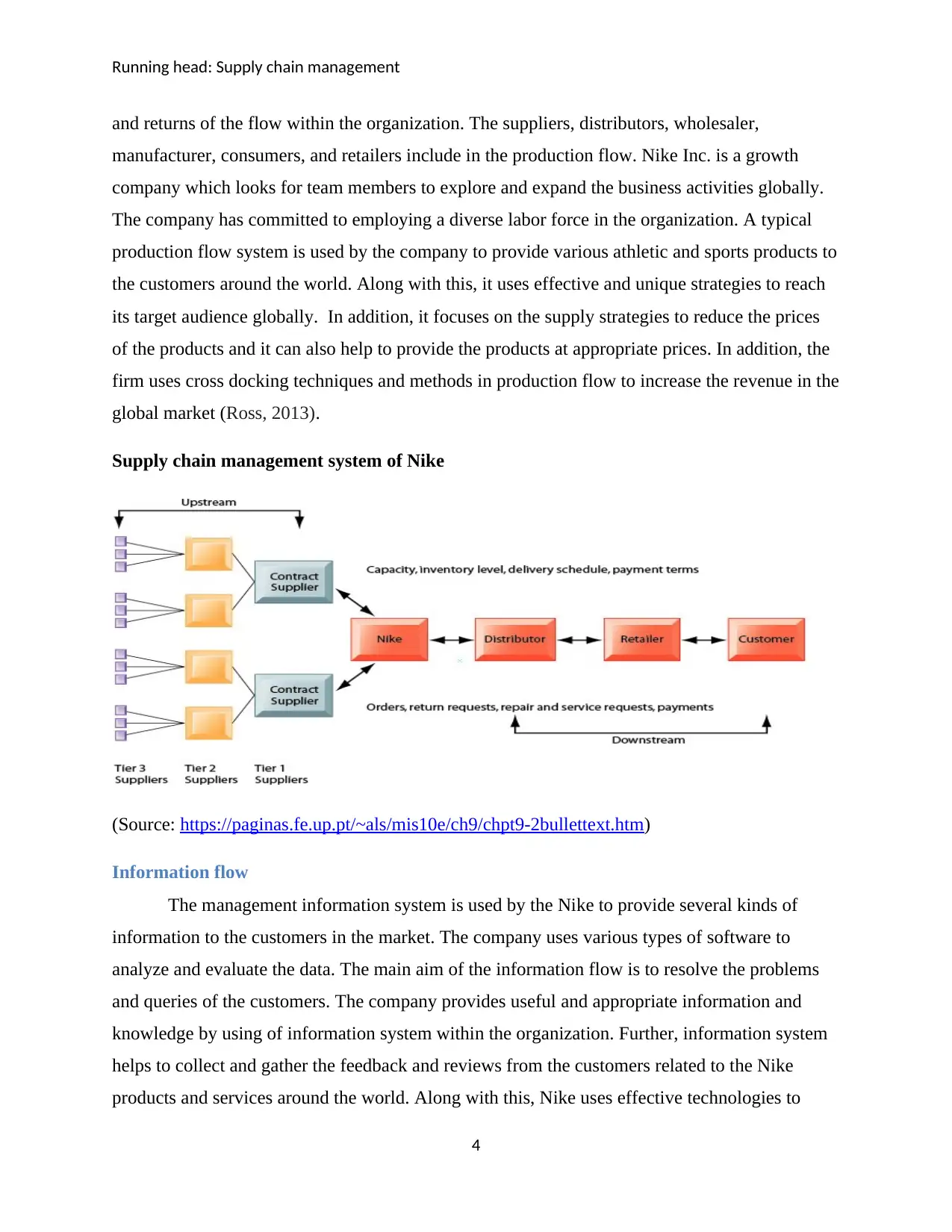
Running head: Supply chain management
and returns of the flow within the organization. The suppliers, distributors, wholesaler,
manufacturer, consumers, and retailers include in the production flow. Nike Inc. is a growth
company which looks for team members to explore and expand the business activities globally.
The company has committed to employing a diverse labor force in the organization. A typical
production flow system is used by the company to provide various athletic and sports products to
the customers around the world. Along with this, it uses effective and unique strategies to reach
its target audience globally. In addition, it focuses on the supply strategies to reduce the prices
of the products and it can also help to provide the products at appropriate prices. In addition, the
firm uses cross docking techniques and methods in production flow to increase the revenue in the
global market (Ross, 2013).
Supply chain management system of Nike
(Source: https://paginas.fe.up.pt/~als/mis10e/ch9/chpt9-2bullettext.htm)
Information flow
The management information system is used by the Nike to provide several kinds of
information to the customers in the market. The company uses various types of software to
analyze and evaluate the data. The main aim of the information flow is to resolve the problems
and queries of the customers. The company provides useful and appropriate information and
knowledge by using of information system within the organization. Further, information system
helps to collect and gather the feedback and reviews from the customers related to the Nike
products and services around the world. Along with this, Nike uses effective technologies to
4
and returns of the flow within the organization. The suppliers, distributors, wholesaler,
manufacturer, consumers, and retailers include in the production flow. Nike Inc. is a growth
company which looks for team members to explore and expand the business activities globally.
The company has committed to employing a diverse labor force in the organization. A typical
production flow system is used by the company to provide various athletic and sports products to
the customers around the world. Along with this, it uses effective and unique strategies to reach
its target audience globally. In addition, it focuses on the supply strategies to reduce the prices
of the products and it can also help to provide the products at appropriate prices. In addition, the
firm uses cross docking techniques and methods in production flow to increase the revenue in the
global market (Ross, 2013).
Supply chain management system of Nike
(Source: https://paginas.fe.up.pt/~als/mis10e/ch9/chpt9-2bullettext.htm)
Information flow
The management information system is used by the Nike to provide several kinds of
information to the customers in the market. The company uses various types of software to
analyze and evaluate the data. The main aim of the information flow is to resolve the problems
and queries of the customers. The company provides useful and appropriate information and
knowledge by using of information system within the organization. Further, information system
helps to collect and gather the feedback and reviews from the customers related to the Nike
products and services around the world. Along with this, Nike uses effective technologies to
4
Secure Best Marks with AI Grader
Need help grading? Try our AI Grader for instant feedback on your assignments.
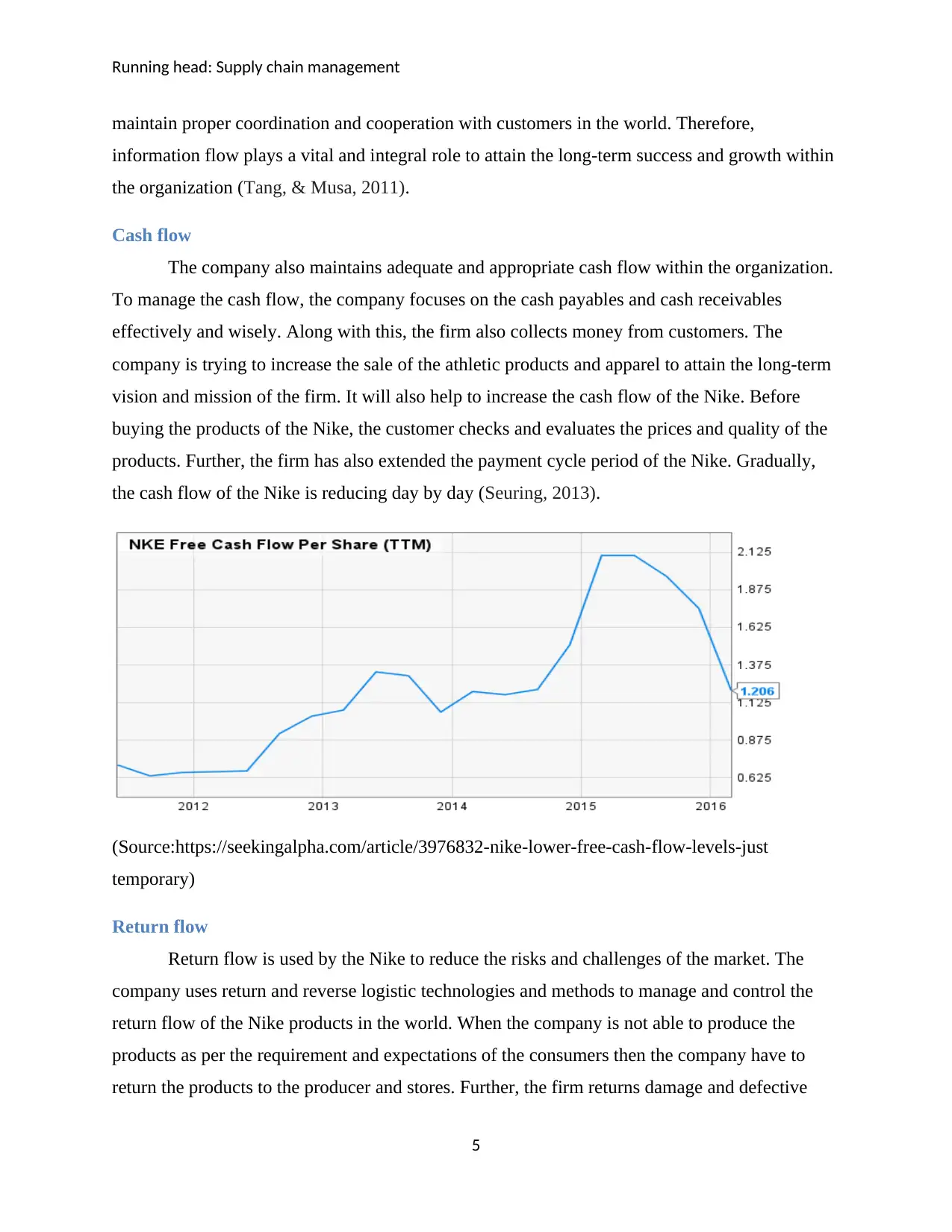
Running head: Supply chain management
maintain proper coordination and cooperation with customers in the world. Therefore,
information flow plays a vital and integral role to attain the long-term success and growth within
the organization (Tang, & Musa, 2011).
Cash flow
The company also maintains adequate and appropriate cash flow within the organization.
To manage the cash flow, the company focuses on the cash payables and cash receivables
effectively and wisely. Along with this, the firm also collects money from customers. The
company is trying to increase the sale of the athletic products and apparel to attain the long-term
vision and mission of the firm. It will also help to increase the cash flow of the Nike. Before
buying the products of the Nike, the customer checks and evaluates the prices and quality of the
products. Further, the firm has also extended the payment cycle period of the Nike. Gradually,
the cash flow of the Nike is reducing day by day (Seuring, 2013).
(Source:https://seekingalpha.com/article/3976832-nike-lower-free-cash-flow-levels-just
temporary)
Return flow
Return flow is used by the Nike to reduce the risks and challenges of the market. The
company uses return and reverse logistic technologies and methods to manage and control the
return flow of the Nike products in the world. When the company is not able to produce the
products as per the requirement and expectations of the consumers then the company have to
return the products to the producer and stores. Further, the firm returns damage and defective
5
maintain proper coordination and cooperation with customers in the world. Therefore,
information flow plays a vital and integral role to attain the long-term success and growth within
the organization (Tang, & Musa, 2011).
Cash flow
The company also maintains adequate and appropriate cash flow within the organization.
To manage the cash flow, the company focuses on the cash payables and cash receivables
effectively and wisely. Along with this, the firm also collects money from customers. The
company is trying to increase the sale of the athletic products and apparel to attain the long-term
vision and mission of the firm. It will also help to increase the cash flow of the Nike. Before
buying the products of the Nike, the customer checks and evaluates the prices and quality of the
products. Further, the firm has also extended the payment cycle period of the Nike. Gradually,
the cash flow of the Nike is reducing day by day (Seuring, 2013).
(Source:https://seekingalpha.com/article/3976832-nike-lower-free-cash-flow-levels-just
temporary)
Return flow
Return flow is used by the Nike to reduce the risks and challenges of the market. The
company uses return and reverse logistic technologies and methods to manage and control the
return flow of the Nike products in the world. When the company is not able to produce the
products as per the requirement and expectations of the consumers then the company have to
return the products to the producer and stores. Further, the firm returns damage and defective
5

Running head: Supply chain management
products to the stores. In this way, the company shows loyalty and faith at the workplace to
increase the number of customers globally (Swink, Melnyk, Cooper & Hartley, 2014).
Recommendations
It has been recommended that Nike should improve the key flows supply chain
management system to manage and control the various activities effectively and wisely. The
company must promote information communication and technology system to maintain
reciprocal cooperation with customers in the market. Along with this, return flow and cash flow
must be managed and evaluated by the Nike to maximize the profit of the firm (Soosay, Fearne
&Varsei, 2014).
The make process
Production planning process
The company manufactures its products in more than 600 factories with an effective and
unique workforce in approx 46 countries. Nike follows vertically integrated model for producing
the apparel and footwear. Along with this, transformation process can be used by the company.
In addition, the company uses effective production planning strategy to do effective and efficient
planning for producing new products in the market. In production planning process, the company
needs to focus on the material, stocks, location and period of production etc. The company
makes effective plans to understand and evaluate the future outcomes and results (Ranganathan,
Teo & Dhaliwal, 2011). The main aim of the production planning process is to predict the types
of resources which are required in an organization for manufacturing the products worldwide.
The four major activities involved in production planning processes such as sequencing, loading,
scheduling, control, and monitoring. Along with this, the company needs to look after the
machines, and material to gain and maximize the profit of the Nike. Apart from this, the
company also focuses on the marketing mix strategy to overcome on the competitors around the
world. Furthermore, the production planning process also includes packaging and annual sales
and operation process of the Nike. Through effective and unique production planning process,
the company is able to produce a variety of the shoe with different color and designs to attain
6
products to the stores. In this way, the company shows loyalty and faith at the workplace to
increase the number of customers globally (Swink, Melnyk, Cooper & Hartley, 2014).
Recommendations
It has been recommended that Nike should improve the key flows supply chain
management system to manage and control the various activities effectively and wisely. The
company must promote information communication and technology system to maintain
reciprocal cooperation with customers in the market. Along with this, return flow and cash flow
must be managed and evaluated by the Nike to maximize the profit of the firm (Soosay, Fearne
&Varsei, 2014).
The make process
Production planning process
The company manufactures its products in more than 600 factories with an effective and
unique workforce in approx 46 countries. Nike follows vertically integrated model for producing
the apparel and footwear. Along with this, transformation process can be used by the company.
In addition, the company uses effective production planning strategy to do effective and efficient
planning for producing new products in the market. In production planning process, the company
needs to focus on the material, stocks, location and period of production etc. The company
makes effective plans to understand and evaluate the future outcomes and results (Ranganathan,
Teo & Dhaliwal, 2011). The main aim of the production planning process is to predict the types
of resources which are required in an organization for manufacturing the products worldwide.
The four major activities involved in production planning processes such as sequencing, loading,
scheduling, control, and monitoring. Along with this, the company needs to look after the
machines, and material to gain and maximize the profit of the Nike. Apart from this, the
company also focuses on the marketing mix strategy to overcome on the competitors around the
world. Furthermore, the production planning process also includes packaging and annual sales
and operation process of the Nike. Through effective and unique production planning process,
the company is able to produce a variety of the shoe with different color and designs to attain
6
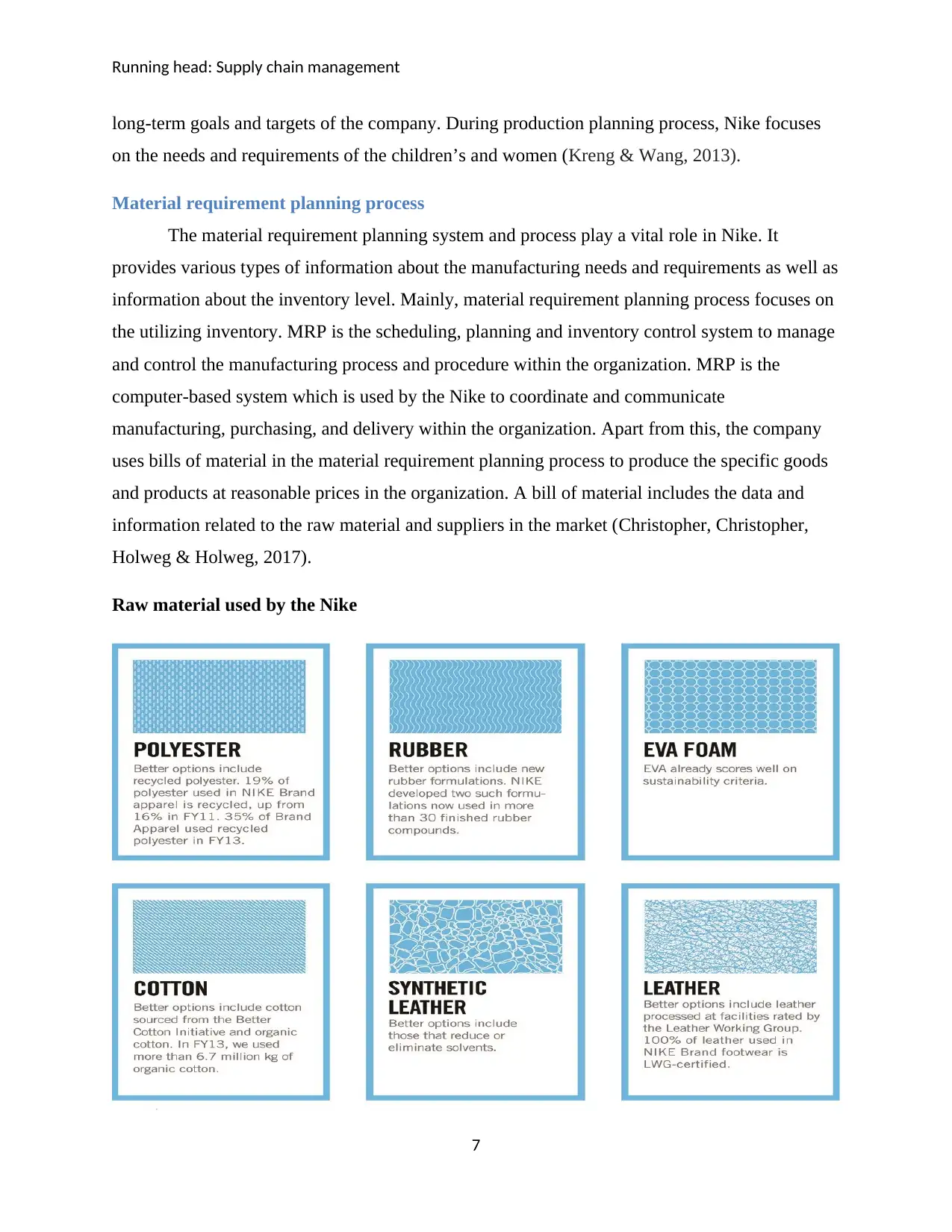
Running head: Supply chain management
long-term goals and targets of the company. During production planning process, Nike focuses
on the needs and requirements of the children’s and women (Kreng & Wang, 2013).
Material requirement planning process
The material requirement planning system and process play a vital role in Nike. It
provides various types of information about the manufacturing needs and requirements as well as
information about the inventory level. Mainly, material requirement planning process focuses on
the utilizing inventory. MRP is the scheduling, planning and inventory control system to manage
and control the manufacturing process and procedure within the organization. MRP is the
computer-based system which is used by the Nike to coordinate and communicate
manufacturing, purchasing, and delivery within the organization. Apart from this, the company
uses bills of material in the material requirement planning process to produce the specific goods
and products at reasonable prices in the organization. A bill of material includes the data and
information related to the raw material and suppliers in the market (Christopher, Christopher,
Holweg & Holweg, 2017).
Raw material used by the Nike
7
long-term goals and targets of the company. During production planning process, Nike focuses
on the needs and requirements of the children’s and women (Kreng & Wang, 2013).
Material requirement planning process
The material requirement planning system and process play a vital role in Nike. It
provides various types of information about the manufacturing needs and requirements as well as
information about the inventory level. Mainly, material requirement planning process focuses on
the utilizing inventory. MRP is the scheduling, planning and inventory control system to manage
and control the manufacturing process and procedure within the organization. MRP is the
computer-based system which is used by the Nike to coordinate and communicate
manufacturing, purchasing, and delivery within the organization. Apart from this, the company
uses bills of material in the material requirement planning process to produce the specific goods
and products at reasonable prices in the organization. A bill of material includes the data and
information related to the raw material and suppliers in the market (Christopher, Christopher,
Holweg & Holweg, 2017).
Raw material used by the Nike
7
Paraphrase This Document
Need a fresh take? Get an instant paraphrase of this document with our AI Paraphraser
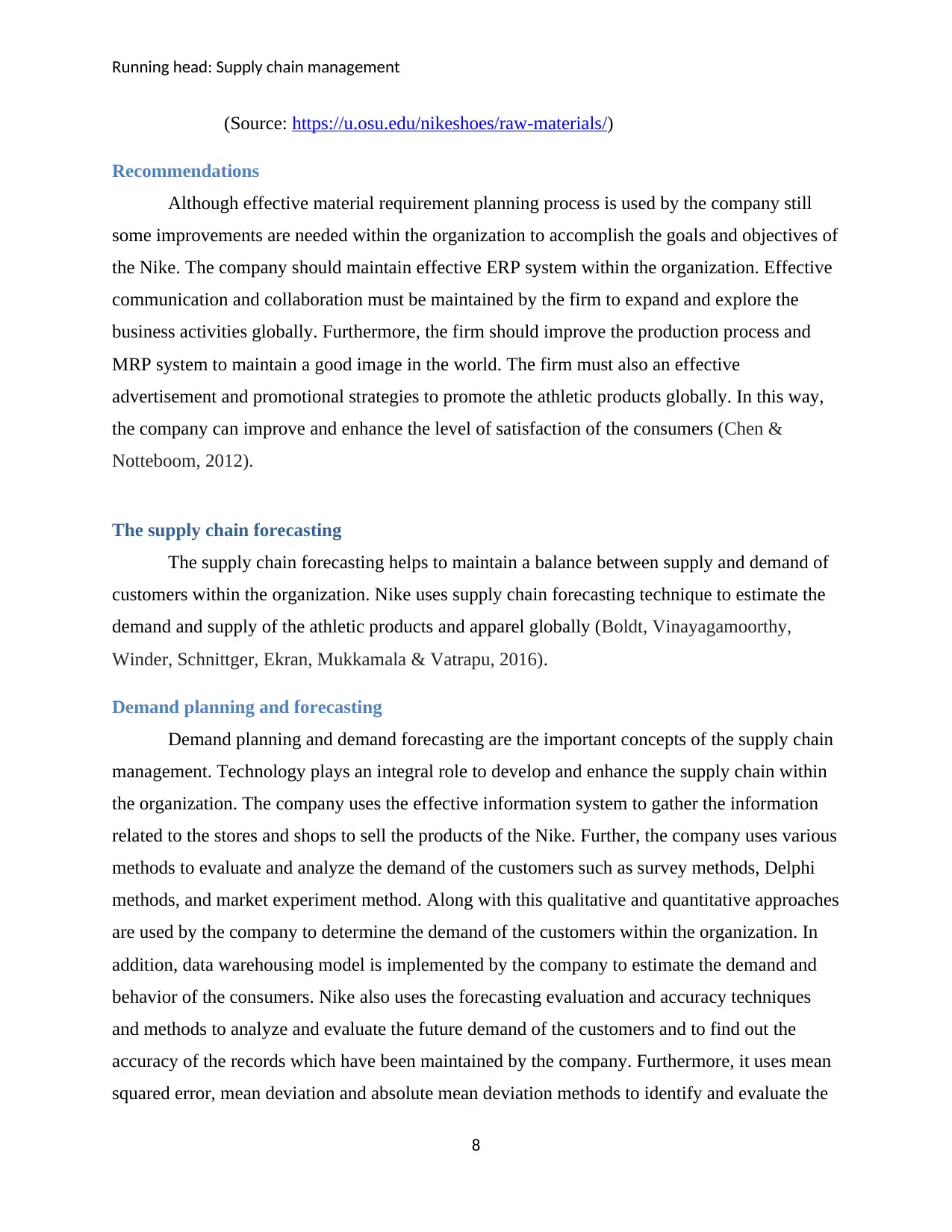
Running head: Supply chain management
(Source: https://u.osu.edu/nikeshoes/raw-materials/)
Recommendations
Although effective material requirement planning process is used by the company still
some improvements are needed within the organization to accomplish the goals and objectives of
the Nike. The company should maintain effective ERP system within the organization. Effective
communication and collaboration must be maintained by the firm to expand and explore the
business activities globally. Furthermore, the firm should improve the production process and
MRP system to maintain a good image in the world. The firm must also an effective
advertisement and promotional strategies to promote the athletic products globally. In this way,
the company can improve and enhance the level of satisfaction of the consumers (Chen &
Notteboom, 2012).
The supply chain forecasting
The supply chain forecasting helps to maintain a balance between supply and demand of
customers within the organization. Nike uses supply chain forecasting technique to estimate the
demand and supply of the athletic products and apparel globally (Boldt, Vinayagamoorthy,
Winder, Schnittger, Ekran, Mukkamala & Vatrapu, 2016).
Demand planning and forecasting
Demand planning and demand forecasting are the important concepts of the supply chain
management. Technology plays an integral role to develop and enhance the supply chain within
the organization. The company uses the effective information system to gather the information
related to the stores and shops to sell the products of the Nike. Further, the company uses various
methods to evaluate and analyze the demand of the customers such as survey methods, Delphi
methods, and market experiment method. Along with this qualitative and quantitative approaches
are used by the company to determine the demand of the customers within the organization. In
addition, data warehousing model is implemented by the company to estimate the demand and
behavior of the consumers. Nike also uses the forecasting evaluation and accuracy techniques
and methods to analyze and evaluate the future demand of the customers and to find out the
accuracy of the records which have been maintained by the company. Furthermore, it uses mean
squared error, mean deviation and absolute mean deviation methods to identify and evaluate the
8
(Source: https://u.osu.edu/nikeshoes/raw-materials/)
Recommendations
Although effective material requirement planning process is used by the company still
some improvements are needed within the organization to accomplish the goals and objectives of
the Nike. The company should maintain effective ERP system within the organization. Effective
communication and collaboration must be maintained by the firm to expand and explore the
business activities globally. Furthermore, the firm should improve the production process and
MRP system to maintain a good image in the world. The firm must also an effective
advertisement and promotional strategies to promote the athletic products globally. In this way,
the company can improve and enhance the level of satisfaction of the consumers (Chen &
Notteboom, 2012).
The supply chain forecasting
The supply chain forecasting helps to maintain a balance between supply and demand of
customers within the organization. Nike uses supply chain forecasting technique to estimate the
demand and supply of the athletic products and apparel globally (Boldt, Vinayagamoorthy,
Winder, Schnittger, Ekran, Mukkamala & Vatrapu, 2016).
Demand planning and forecasting
Demand planning and demand forecasting are the important concepts of the supply chain
management. Technology plays an integral role to develop and enhance the supply chain within
the organization. The company uses the effective information system to gather the information
related to the stores and shops to sell the products of the Nike. Further, the company uses various
methods to evaluate and analyze the demand of the customers such as survey methods, Delphi
methods, and market experiment method. Along with this qualitative and quantitative approaches
are used by the company to determine the demand of the customers within the organization. In
addition, data warehousing model is implemented by the company to estimate the demand and
behavior of the consumers. Nike also uses the forecasting evaluation and accuracy techniques
and methods to analyze and evaluate the future demand of the customers and to find out the
accuracy of the records which have been maintained by the company. Furthermore, it uses mean
squared error, mean deviation and absolute mean deviation methods to identify and evaluate the
8
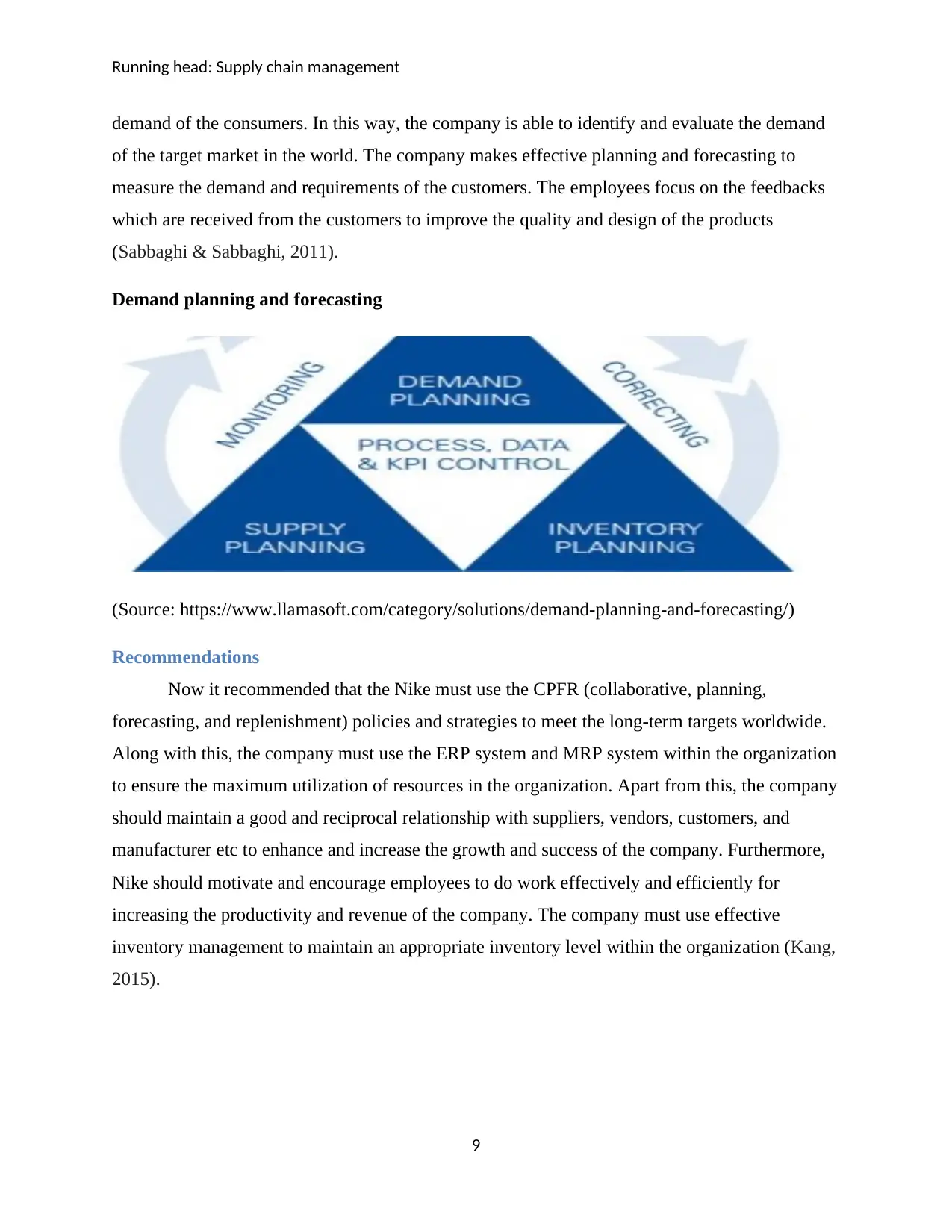
Running head: Supply chain management
demand of the consumers. In this way, the company is able to identify and evaluate the demand
of the target market in the world. The company makes effective planning and forecasting to
measure the demand and requirements of the customers. The employees focus on the feedbacks
which are received from the customers to improve the quality and design of the products
(Sabbaghi & Sabbaghi, 2011).
Demand planning and forecasting
(Source: https://www.llamasoft.com/category/solutions/demand-planning-and-forecasting/)
Recommendations
Now it recommended that the Nike must use the CPFR (collaborative, planning,
forecasting, and replenishment) policies and strategies to meet the long-term targets worldwide.
Along with this, the company must use the ERP system and MRP system within the organization
to ensure the maximum utilization of resources in the organization. Apart from this, the company
should maintain a good and reciprocal relationship with suppliers, vendors, customers, and
manufacturer etc to enhance and increase the growth and success of the company. Furthermore,
Nike should motivate and encourage employees to do work effectively and efficiently for
increasing the productivity and revenue of the company. The company must use effective
inventory management to maintain an appropriate inventory level within the organization (Kang,
2015).
9
demand of the consumers. In this way, the company is able to identify and evaluate the demand
of the target market in the world. The company makes effective planning and forecasting to
measure the demand and requirements of the customers. The employees focus on the feedbacks
which are received from the customers to improve the quality and design of the products
(Sabbaghi & Sabbaghi, 2011).
Demand planning and forecasting
(Source: https://www.llamasoft.com/category/solutions/demand-planning-and-forecasting/)
Recommendations
Now it recommended that the Nike must use the CPFR (collaborative, planning,
forecasting, and replenishment) policies and strategies to meet the long-term targets worldwide.
Along with this, the company must use the ERP system and MRP system within the organization
to ensure the maximum utilization of resources in the organization. Apart from this, the company
should maintain a good and reciprocal relationship with suppliers, vendors, customers, and
manufacturer etc to enhance and increase the growth and success of the company. Furthermore,
Nike should motivate and encourage employees to do work effectively and efficiently for
increasing the productivity and revenue of the company. The company must use effective
inventory management to maintain an appropriate inventory level within the organization (Kang,
2015).
9

Running head: Supply chain management
Conclusion
On the above discussion, it has been evaluated that Nike plays a vital and significant role
in order to attain the long-term success and growth within the organization. Furthermore, the
company uses effective supply chain management and ERP system to fulfill the requirements
and desires of the customers in the organization. In addition, effective and successful production
planning process and MRP system are used by the company in order to beat the competitors and
to maintain sustainability within the organization. Apart from this, the company is also
improving its demand forecasting model to increase the sales of the customers within the
organization. Nike uses various key flows of the supply chain management to manage and
handle the activities of the business. Nike must improve its strategies, plans, and policies to gain
competitive advantages in the global market (Acar & Gardner, 2012).
10
Conclusion
On the above discussion, it has been evaluated that Nike plays a vital and significant role
in order to attain the long-term success and growth within the organization. Furthermore, the
company uses effective supply chain management and ERP system to fulfill the requirements
and desires of the customers in the organization. In addition, effective and successful production
planning process and MRP system are used by the company in order to beat the competitors and
to maintain sustainability within the organization. Apart from this, the company is also
improving its demand forecasting model to increase the sales of the customers within the
organization. Nike uses various key flows of the supply chain management to manage and
handle the activities of the business. Nike must improve its strategies, plans, and policies to gain
competitive advantages in the global market (Acar & Gardner, 2012).
10
Secure Best Marks with AI Grader
Need help grading? Try our AI Grader for instant feedback on your assignments.
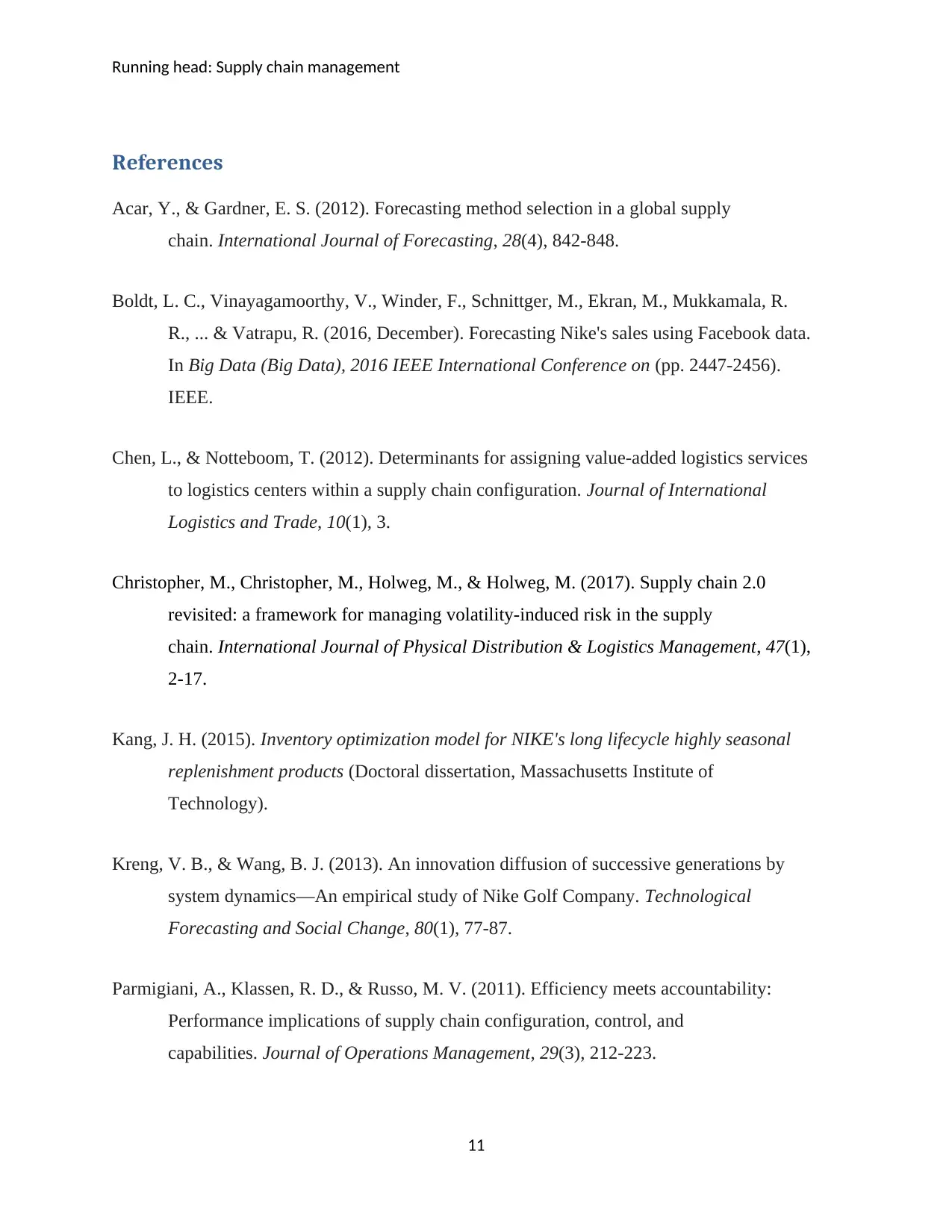
Running head: Supply chain management
References
Acar, Y., & Gardner, E. S. (2012). Forecasting method selection in a global supply
chain. International Journal of Forecasting, 28(4), 842-848.
Boldt, L. C., Vinayagamoorthy, V., Winder, F., Schnittger, M., Ekran, M., Mukkamala, R.
R., ... & Vatrapu, R. (2016, December). Forecasting Nike's sales using Facebook data.
In Big Data (Big Data), 2016 IEEE International Conference on (pp. 2447-2456).
IEEE.
Chen, L., & Notteboom, T. (2012). Determinants for assigning value-added logistics services
to logistics centers within a supply chain configuration. Journal of International
Logistics and Trade, 10(1), 3.
Christopher, M., Christopher, M., Holweg, M., & Holweg, M. (2017). Supply chain 2.0
revisited: a framework for managing volatility-induced risk in the supply
chain. International Journal of Physical Distribution & Logistics Management, 47(1),
2-17.
Kang, J. H. (2015). Inventory optimization model for NIKE's long lifecycle highly seasonal
replenishment products (Doctoral dissertation, Massachusetts Institute of
Technology).
Kreng, V. B., & Wang, B. J. (2013). An innovation diffusion of successive generations by
system dynamics—An empirical study of Nike Golf Company. Technological
Forecasting and Social Change, 80(1), 77-87.
Parmigiani, A., Klassen, R. D., & Russo, M. V. (2011). Efficiency meets accountability:
Performance implications of supply chain configuration, control, and
capabilities. Journal of Operations Management, 29(3), 212-223.
11
References
Acar, Y., & Gardner, E. S. (2012). Forecasting method selection in a global supply
chain. International Journal of Forecasting, 28(4), 842-848.
Boldt, L. C., Vinayagamoorthy, V., Winder, F., Schnittger, M., Ekran, M., Mukkamala, R.
R., ... & Vatrapu, R. (2016, December). Forecasting Nike's sales using Facebook data.
In Big Data (Big Data), 2016 IEEE International Conference on (pp. 2447-2456).
IEEE.
Chen, L., & Notteboom, T. (2012). Determinants for assigning value-added logistics services
to logistics centers within a supply chain configuration. Journal of International
Logistics and Trade, 10(1), 3.
Christopher, M., Christopher, M., Holweg, M., & Holweg, M. (2017). Supply chain 2.0
revisited: a framework for managing volatility-induced risk in the supply
chain. International Journal of Physical Distribution & Logistics Management, 47(1),
2-17.
Kang, J. H. (2015). Inventory optimization model for NIKE's long lifecycle highly seasonal
replenishment products (Doctoral dissertation, Massachusetts Institute of
Technology).
Kreng, V. B., & Wang, B. J. (2013). An innovation diffusion of successive generations by
system dynamics—An empirical study of Nike Golf Company. Technological
Forecasting and Social Change, 80(1), 77-87.
Parmigiani, A., Klassen, R. D., & Russo, M. V. (2011). Efficiency meets accountability:
Performance implications of supply chain configuration, control, and
capabilities. Journal of Operations Management, 29(3), 212-223.
11

Running head: Supply chain management
Qrunfleh, S., & Tarafdar, M. (2014). Supply chain information systems strategy: Impacts on
supply chain performance and firm performance. International Journal of Production
Economics, 147, 340-350.
Ranganathan, C., Teo, T. S., & Dhaliwal, J. (2011). Web-enabled supply chain management:
Key antecedents and performance impacts. International Journal of Information
Management, 31(6), 533-545.
Ross, D. F. (2013). Competing through supply chain management: creating market-winning
strategies through supply chain partnerships. Springer Science & Business Media.
Sabbaghi, A., & Sabbaghi, N. (2011). Global supply-chain strategy and global
competitiveness. International Business & Economics Research Journal (IBER), 3(7).
Seuring, S. (2013). A review of modeling approaches for sustainable supply chain
management. Decision support systems, 54(4), 1513-1520.
Soosay, C., Fearne, A., &Varsei, M. (2014). Extending sustainable practices beyond
organizations to supply chains. In Linking Local and Global Sustainability (pp. 71-90).
Springer Netherlands.
Swink, M., Melnyk, S.A., Cooper, M.B. & Hartley, J.L. (2014). Managing operations across the
supply chain (pp. 248-249), New York, NY: McGraw-Hill/Irwin.
Swink, M., Melnyk, S.A., Cooper, M.B. and Hartley, J.L. (2014). Managing operations across
the supply chain (pp. 248-249), New York, NY: McGraw-Hill/Irwin.
Tang, O., & Musa, S. N. (2011). Identifying risk issues and research advancements in supply
chain risk management. International journal of production economics, 133(1), 25-34.
12
Qrunfleh, S., & Tarafdar, M. (2014). Supply chain information systems strategy: Impacts on
supply chain performance and firm performance. International Journal of Production
Economics, 147, 340-350.
Ranganathan, C., Teo, T. S., & Dhaliwal, J. (2011). Web-enabled supply chain management:
Key antecedents and performance impacts. International Journal of Information
Management, 31(6), 533-545.
Ross, D. F. (2013). Competing through supply chain management: creating market-winning
strategies through supply chain partnerships. Springer Science & Business Media.
Sabbaghi, A., & Sabbaghi, N. (2011). Global supply-chain strategy and global
competitiveness. International Business & Economics Research Journal (IBER), 3(7).
Seuring, S. (2013). A review of modeling approaches for sustainable supply chain
management. Decision support systems, 54(4), 1513-1520.
Soosay, C., Fearne, A., &Varsei, M. (2014). Extending sustainable practices beyond
organizations to supply chains. In Linking Local and Global Sustainability (pp. 71-90).
Springer Netherlands.
Swink, M., Melnyk, S.A., Cooper, M.B. & Hartley, J.L. (2014). Managing operations across the
supply chain (pp. 248-249), New York, NY: McGraw-Hill/Irwin.
Swink, M., Melnyk, S.A., Cooper, M.B. and Hartley, J.L. (2014). Managing operations across
the supply chain (pp. 248-249), New York, NY: McGraw-Hill/Irwin.
Tang, O., & Musa, S. N. (2011). Identifying risk issues and research advancements in supply
chain risk management. International journal of production economics, 133(1), 25-34.
12

Running head: Supply chain management
13
13
1 out of 13
Related Documents
Your All-in-One AI-Powered Toolkit for Academic Success.
+13062052269
info@desklib.com
Available 24*7 on WhatsApp / Email
![[object Object]](/_next/static/media/star-bottom.7253800d.svg)
Unlock your academic potential
© 2024 | Zucol Services PVT LTD | All rights reserved.





